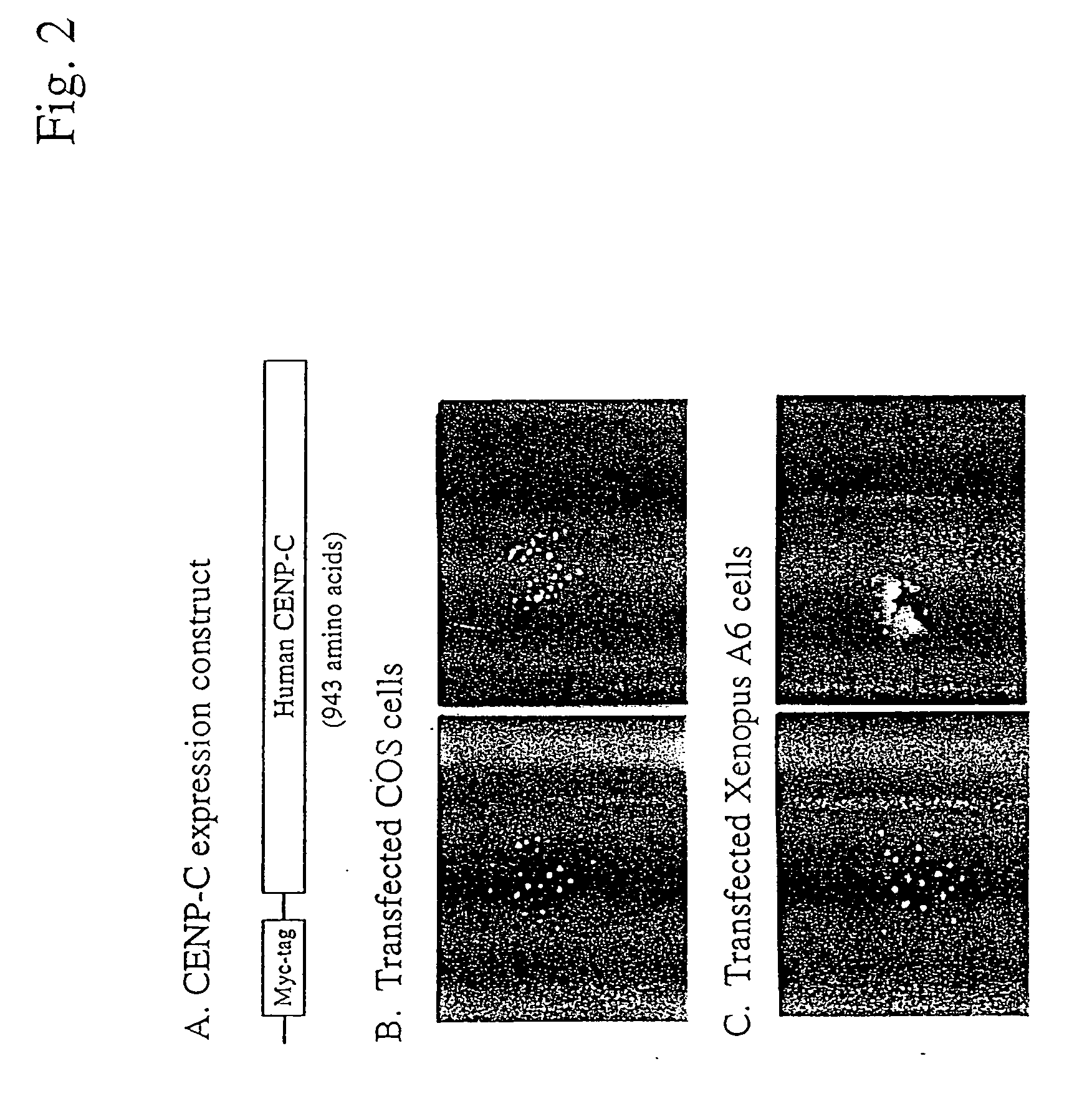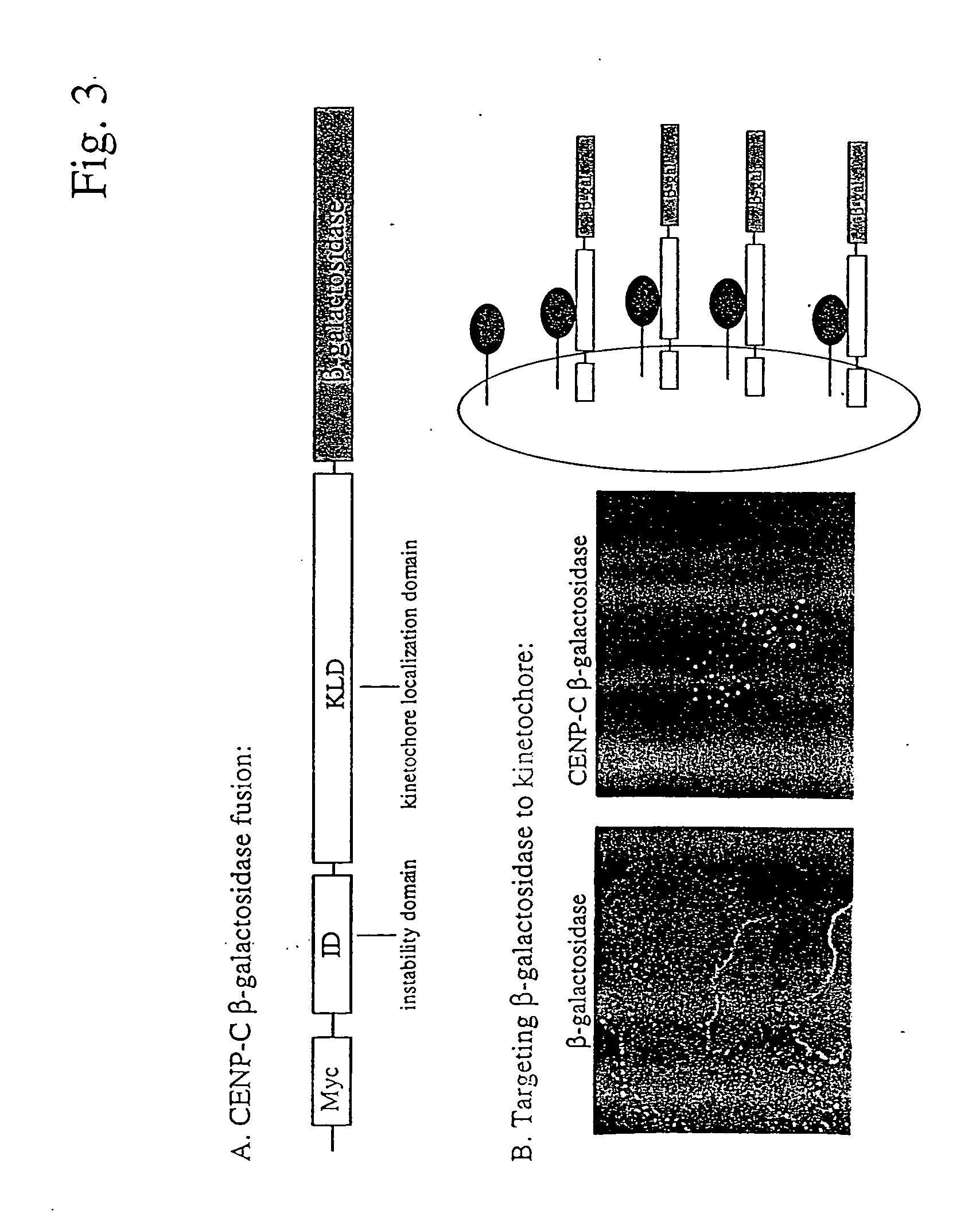Compositions and methods for the identification of protein interactions in vertebrate cells
a technology of protein interactions and compositions, applied in the field of compositions and methods for the identification of protein interactions in vertebrate cells, can solve the problems of inflexibility, inability to meet the needs of a wide range of cells, and inability to use mammalian systems, and achieve the effect of shortening the half-life of the detection domain and shortening the intracellular half-li
- Summary
- Abstract
- Description
- Claims
- Application Information
AI Technical Summary
Benefits of technology
Problems solved by technology
Method used
Image
Examples
example 1
Localization of Kinetochore Proteins at Discrete Subcellular Sites
[0241] The kinetochore is a multiprotein complex which assembles at the centromere of chromosomes. Kinetochore interactions with spindle microtubules during mitosis play critical roles in the alignment of chromosomes and the segregation of sister chromatids. Patients with the calcinosis / Raynaud's phenomenon / esophageal dysmotility / sclerodactyly / telangiectasia variant (or CREST syndrome) of scleroderma produce autoantibodies to kinetochore proteins and that these antigens were present on both interphase and mitotic chromosomes (Moroi Y, et al., Proc Natl Acad Sci USA, 77:1627-31 (1980)). These antibodies have been employed to identify cDNAs encoding several of the kinetochore antigens, including CENP-A, CENP-13, and CENP-C (Moroi Y, et al., Proc Natl Acad Sci USA, 77:1627-31 (1980); Maney T, et al., Int Rev Cytol, 194: 67-131 (2000)). As seen in FIG. 1, the pattern of kinetochore labeling is discrete, uniform, and inte...
example 2
Targeting of Myc-Tagged Human CENP-C to Kinetochores
[0243] CENP-C possesses several important characteristics which render it an ideal platform for the two-hybrid system in animal cells described herein. Exogenous human CENP-C can be expressed in cells using standard transfection techniques and this “tagged”-CENP-C will label each kinetochore in the cells (Lanini L and McKeon F, Mol Biol Cell, 6:1049-1059 (1995)). Thus the information for targeting and assembly of CENP-C at the kinetochore is completely contained within the CENP-C coding sequence.
[0244]FIG. 2 shows the targeting of myc-tagged human CENP-C to kinetochores. Panel A shows the expression construct used in these experiments. Panel B shows the expression of human myc-tagged CENP-C in COS (African green monkey) cells with targeting to kinetochores in both interphase (left panel) and metaphase (right panel). Anti-Myc staining is shown in red, while DNA staining with Hoeschst dye is shown in blue. Panel C shows human CENP-...
example 3
Targeting of CENP-C-Beta-Galactosidase Fusion to the Kinetochore
[0246] Fusions between CENP-C and unrelated proteins, such as beta-galactosidase, can be expressed in cells and ectopically target the fused protein to the kinetochore (FIG. 3). Therefore, the patterning of the kinetochores, a numerically and spacially precise array, can be used to assay for interacting proteins which assume the identical pattern. The kinetochore pattern is a numerically defined entity in the cell and therefore easily “scoreable” visually or by using automated detection systems. Similar two-hybrid screens could be developed by linking the “bait” proteins to any protein that has a particular subcellular localization.
[0247]FIG. 3 shows the targeting of CENP-C-beta-galactosidase to the kinetochore. Panel A shows the expression construct used in these experiments. The construct contains CENP-C coding sequences, including the instability domain (ID) and the kintochore localization domain (KLD), fused in-fr...
PUM
| Property | Measurement | Unit |
|---|---|---|
| dissociation constant | aaaaa | aaaaa |
| dissociation constant | aaaaa | aaaaa |
| dissociation constant | aaaaa | aaaaa |
Abstract
Description
Claims
Application Information
 Login to View More
Login to View More - R&D
- Intellectual Property
- Life Sciences
- Materials
- Tech Scout
- Unparalleled Data Quality
- Higher Quality Content
- 60% Fewer Hallucinations
Browse by: Latest US Patents, China's latest patents, Technical Efficacy Thesaurus, Application Domain, Technology Topic, Popular Technical Reports.
© 2025 PatSnap. All rights reserved.Legal|Privacy policy|Modern Slavery Act Transparency Statement|Sitemap|About US| Contact US: help@patsnap.com



